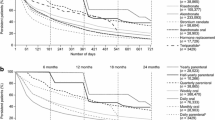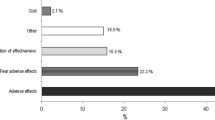Abstract
Summary
This database analysis of over 4,000 German women prescribed oral bisphosphonates between December 2004 and November 2007 showed that compliance and persistence with oral bisphosphonates in German women with osteoporosis were inadequate.
Introduction
GRAND is a database analysis designed to investigate persistence and compliance with oral bisphosphonate regimens, and their association with fracture incidence, in women with osteoporosis.
Methods
Diagnostic, treatment and fracture data were obtained from the IMS® Disease Analyzer patient database in Germany. Women with osteoporosis prescribed one of six specified oral bisphosphonates between December 2004 and November 2007 with no similar prescription for at least 1 year beforehand were eligible for analysis. Those treated with intravenous bisphosphonates were excluded. Persistence (prescription refill gap of ≤30 days or change of treatment frequency) and compliance (medication possession ratio) were measured for 2 years from therapy start.
Results
Data from 4,147 women were evaluable, with a median oral bisphosphonate treatment duration of 145.5 days. Persistence rates after 1 and 2 years were 27.9% and 12.9%, respectively, and 66.3% of women were compliant. As expected, persistence rates were higher when the refill gap was increased to 60 or 90 days. No significant differences in 1-year persistence between patients on weekly or monthly treatment regimens were observed (28.6% and 29.4%, respectively), although 1-year persistence with daily treatment was only 7.2%. After 24 months of therapy, compliant women had fewer fractures than non-compliant women (88.1% and 85.0% fracture-free, respectively; p = 0.0147). In multivariate Cox regression analysis, treatment compliance was the only factor that significantly decreased fracture risk (p = 0.0034).
Conclusions
Compliance and persistence with oral bisphosphonates in German women with osteoporosis were inadequate. Better compliance and persistence can prevent fractures in these women.




Similar content being viewed by others
References
Kanis JA, Reginster JY (2008) European guidance for the diagnosis and management of osteoporosis in postmenopausal women—what is the current message for clinical practice? Pol Arch Med Wewn 118:538–540
Cooper C (1999) Epidemiology of osteoporosis. Osteoporos Int 9(Suppl 2):S2–S8
Reginster JY, Burlet N (2006) Osteoporosis: a still increasing prevalence. Bone 38(Suppl 1):4–9
Cole ZA, Dennison EM, Cooper C (2008) Osteoporosis epidemiology update. Curr Rheumatol Rep 10:92–96
Glüer CC, Eastell R, Reid DM, Felsenberg D, Roux C, Barkmann R, Timm W, Blenk T, Armbrecht G, Stewart A, Clowes J, Thomasius FE, Kolta S (2004) Association of five quantitative ultrasound devices and bone densitometry with osteoporotic vertebral fractures in a population-based sample: the OPUS Study. J Bone Miner Res 19:782–793
Haussler B, Gothe H, Gol D, Glaeske G, Pientka L, Felsenberg D (2007) Epidemiology, treatment and costs of osteoporosis in Germany—the BoneEVA Study. Osteoporos Int 18:77–84
Ismail AA, Pye SR, Cockerill WC, Lunt M, Silman AJ, Reeve J, Banzer D, Benevolenskaya LI, Bhalla A, Bruges AJ, Cannata JB, Cooper C, Delmas PD, Dequeker J, Dilsen G, Falch JA, Felsch B, Felsenberg D, Finn JD, Gennari C, Hoszowski K, Jajic I, Janott J, Johnell O, Kanis JA, Kragl G, Lopez VA, Lorenc R, Lyritis G, Marchand F, Masaryk P, Matthis C, Miazgowski T, Naves-Diaz M, Pols HA, Poor G, Rapado A, Raspe HH, Reid DM, Reisinger W, Scheidt-Nave C, Stepan J, Todd C, Weber K, Woolf AD, O’Neill TW (2002) Incidence of limb fracture across Europe: results from the European Prospective Osteoporosis Study (EPOS). Osteoporos Int 13:565–571
Kanis JA, Johnell O, Oden A, Dawson A, De Laet C, Jonsson B (2001) Ten year probabilities of osteoporotic fractures according to BMD and diagnostic thresholds. Osteoporos Int 12:989–995
Kanis JA, Burlet N, Cooper C, Delmas PD, Reginster JY, Borgstrom F, Rizzoli R, European Society for Clinical and Economic Aspects of Osteoporosis and Osteoarthritis (ESCEO) (2008) European guidance for the diagnosis and management of osteoporosis in postmenopausal women. Osteoporos Int 19:399–428
Dachverbands der Deutschsprachigen Wissenschaftlichen Osteologischen Gesellschaften e.V (2009) DVO-Leitlinie 2009 zur Prophylaxe, Diagnostik und Therapie der Osteoporose bei Erwachsenen. Osteologie 4:304–324
Brankin E, Walker M, Lynch N, Aspray T, Lis Y, Cowell W (2006) The impact of dosing frequency on compliance and persistence with bisphosphonates among postmenopausal women in the UK: evidence from three databases. Curr Med Res Opin 22:1249–1256
Cotte FE, Mercier F, De PG (2008) Relationship between compliance and persistence with osteoporosis medications and fracture risk in primary health care in France: a retrospective case–control analysis. Clin Ther 30:2410–2422
Curtis JR, Westfall AO, Cheng H, Lyles K, Saag KG, Delzell E (2008) Benefit of adherence with bisphosphonates depends on age and fracture type: results from an analysis of 101,038 new bisphosphonate users. J Bone Miner Res 23:1435–1441
Penning-van Beest FJA, Erkens JA, Olson M, Herings RM (2008) Loss of treatment benefit due to low compliance with bisphosphonate therapy. Osteoporos Int 19:511–517
Rabenda V, Mertens R, Fabri V, Vanoverloop J, Sumkay F, Vannecke C, Deswaef A, Verpooten GA, Reginster JY (2008) Adherence to bisphosphonates therapy and hip fracture risk in osteoporotic women. Osteoporos Int 19:811–818
Weycker D, Macarios D, Edelsberg J, Oster G (2007) Compliance with osteoporosis drug therapy and risk of fracture. Osteoporos Int 18:271–277
Adachi J, Lynch N, Middelhoven H, Hunjan M, Cowell W (2007) The association between compliance and persistence with bisphosphonate therapy and fracture risk: a review. BMC Musculoskelet Disord 8:97
Cramer JA, Lynch NO, Gaudin AF, Walker M, Cowell W (2006) The effect of dosing frequency on compliance and persistence with bisphosphonate therapy in postmenopausal women: a comparison of studies in the United States, the United Kingdom, and France. Clin Ther 28:1686–1694
Cramer JA, Gold DT, Silverman SL, Lewiecki EM (2007) A systematic review of persistence and compliance with bisphosphonates for osteoporosis. Osteoporos Int 18:1023–1031
Kertes J, Dushenat M, Vesterman JL, Lemberger J, Bregman J, Friedman N (2008) Factors contributing to compliance with osteoporosis medication. Isr Med Assoc J 10:207–213
Recker RR, Gallagher R, MacCosbe PE (2005) Effect of dosing frequency on bisphosphonate medication adherence in a large longitudinal cohort of women. Mayo Clin Proc 80:856–861
Bartl R, Gotte S, Hadji P, Hammerschmidt T (2006) Adherence with daily and weekly administration of oral bisphosphonates for osteoporosis treatment. Dtsch Med Wochenschr 131:1257–1262
Höer A, Seidlitz C, Gothe H, Schiffhorst G, Olson M, Hadji P, Häussler B (2009) Influence on persistence and adherence with oral bisphosphonates on fracture rates in osteoporosis. Patient Prefer Adherence 3:25–30
Becher H, Kostev K, Schroder-Bernhardi D (2009) Validity and representativeness of the “Disease Analyzer” patient database for use in pharmacoepidemiological and pharmacoeconomic studies. Int J Clin Pharmacol Ther 47:617–626
DIMDI (2007) ICD-10-GM version 2008. Deutsches Institut für Medizinische Dokumentation und Information, Cologne
DGEpi (2010) Leitlinien Und Empfehlungen Zur Sicherung Von Guter Epidemiologischer Praxis. Deutsche Gesellschaft für Epidemiologie, Hannover
Siris ES, Selby PL, Saag KG, Borgstrom F, Herings RM, Silverman SL (2009) Impact of osteoporosis treatment adherence on fracture rates in North America and Europe. Am J Med 122:S3–S13
Yeaw J, Benner JS, Walt JG, Sian S, Smith DB (2009) Comparing adherence and persistence across 6 chronic medication classes. J Manag Care Pharm 15:728–740
Rabenda V, Hiligsmann M, Reginster JY (2009) Poor adherence to oral bisphosphonate treatment and its consequences: a review of the evidence. Expert Opin Pharmacother 10:2303–2315
Siris ES, Harris ST, Rosen CJ, Barr CE, Arvesen JN, Abbott TA, Silverman S (2006) Adherence to bisphosphonate therapy and fracture rates in osteoporotic women: relationship to vertebral and nonvertebral fractures from 2 US claims databases. Mayo Clin Proc 81:1013–1022
Briesacher BA, Andrade SE, Fouayzi H, Chan KA (2008) Comparison of drug adherence rates among patients with seven different medical conditions. Pharmacotherapy 28:437–443
Huybrechts KF, Ishak KJ, Caro JJ (2006) Assessment of compliance with osteoporosis treatment and its consequences in a managed care population. Bone 38:922–928
Col N, Fanale JE, Kronholm P (1990) The role of medication noncompliance and adverse drug reactions in hospitalizations of the elderly. Arch Intern Med 150:841–845
Cranney A, Jamal SA, Tsang JF, Josse RG, Leslie WD (2007) Low bone mineral density and fracture burden in postmenopausal women. CMAJ 177:575–580
Blouin J, Dragomir A, Fredette M, Ste-Marie LG, Fernandes JC, Perreault S (2009) Comparison of direct health care costs related to the pharmacological treatment of osteoporosis and to the management of osteoporotic fractures among compliant and noncompliant users of alendronate and risedronate: a population-based study. Osteoporos Int 20:1571–1581
Guilera M, Fuentes M, Grifols M, Ferrer J, Badia X (2006) Does an educational leaflet improve self-reported adherence to therapy in osteoporosis? The OPTIMA Study. Osteoporos Int 17:664–671
Reginster JY (2006) Adherence and persistence: impact on outcomes and health care resources. Bone 38(Suppl 2):S18–S21
Schousboe JT, Dowd BE, Davison ML, Kane RL (2010) Association of medication attitudes with non-persistence and non-compliance with medication to prevent fractures. Osteoporos Int 21:1899–1909
Haynes RB, McKibbon KA, Kanani R (1996) Systematic review of randomised trials of interventions to assist patients to follow prescriptions for medications. Lancet 348:383–386
Haynes RB, Ackloo E, Sahota N, McDonald HP, Yao X (2008) Interventions for enhancing medication adherence. Cochrane Database Syst Rev:CD000011
Castelo-Branco C, Cortés X, Ferrer M (2010) Treatment persistence and compliance with a combination of calcium and vitamin D. Climacteric 13:578–584
Huas D, Debiais F, Blotman F, Cortet B, Mercier F, Rousseaux C, Berger V, Gaudin AF, Cotté FE (2010) Compliance and treatment satisfaction of post menopausal women treated for osteoporosis. Compliance with osteoporosis treatment. BMC Womens Health 10:26
Cotté FE, Fardellone P, Mercier F, Gaudin AF, Roux C (2009) Adherence to monthly and weekly oral bisphosphonates in women with osteoporosis. Osteoporos Int 21:145–155
Silverman SL, Schousboe JT, Gold DT (2011) Oral bisphosphonate compliance and persistence: a matter of choice? Osteoporos Int 22:21–26
Ojeda-Bruno S, Naranjo A, Francisco-Hernández F, Erausquin C, Rúa-Figueroa I, Quevedo JC, Rodríguez-Lozano C (2011) Secondary prevention program for osteoporotic fractures and long-term adherence to bisphosphonates. Osteoporos Int. doi:10.1007/s00198-010-1414-z
Acknowledgements
This study was sponsored by Amgen (Europe) GmbH. Amgen (Europe) GmbH and GlaxoSmithKline Ltd. provided funds to Bioscript Stirling Ltd. for editing/formatting assistance and to Surfmedia for graphics support.
Conflicts of interest
Dr. Hadji has received honoraria, unrestricted educational grants and research funding from the following companies: Amgen, AstraZeneca, Eli Lilly, GlaxoSmithKline, Novartis, Pfizer, Procter & Gamble and Roche. Dr. Ziller has no conflict of interest. V Claus and K Kostev are employees of IMS Health GmbH & Co. OHG. T Steinle is an employee of Amgen, Germany. M Intorcia is an employee of Amgen (Europe), Switzerland.
Author information
Authors and Affiliations
Corresponding author
Rights and permissions
About this article
Cite this article
Hadji, P., Claus, V., Ziller, V. et al. GRAND: the German retrospective cohort analysis on compliance and persistence and the associated risk of fractures in osteoporotic women treated with oral bisphosphonates. Osteoporos Int 23, 223–231 (2012). https://doi.org/10.1007/s00198-011-1535-z
Received:
Accepted:
Published:
Issue Date:
DOI: https://doi.org/10.1007/s00198-011-1535-z




